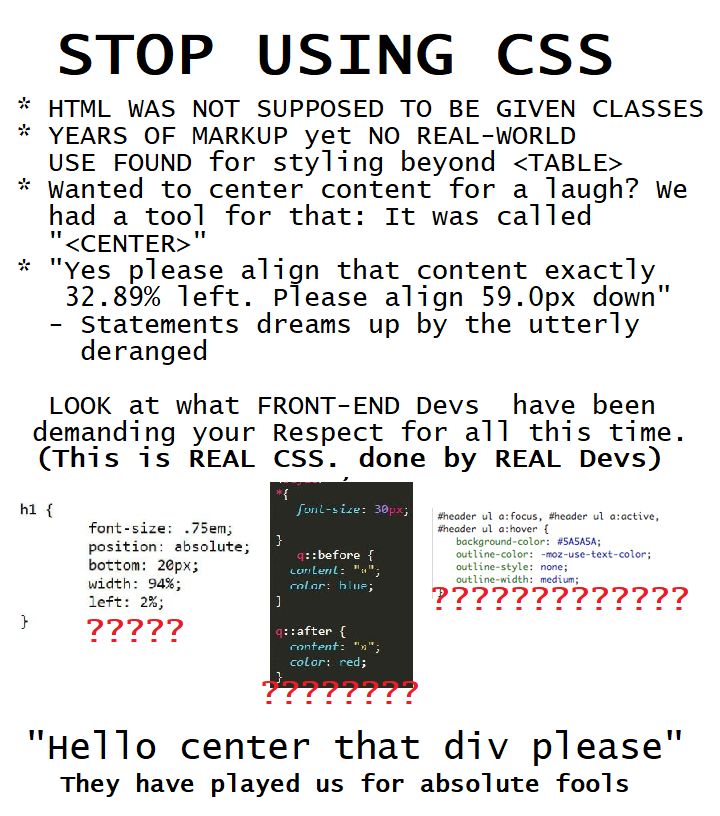this post was submitted on 28 Jul 2023
900 points (96.1% liked)
Programmer Humor
19932 readers
3252 users here now
Welcome to Programmer Humor!
This is a place where you can post jokes, memes, humor, etc. related to programming!
For sharing awful code theres also Programming Horror.
Rules
- Keep content in english
- No advertisements
- Posts must be related to programming or programmer topics
founded 2 years ago
MODERATORS
you are viewing a single comment's thread
view the rest of the comments
view the rest of the comments

I think that the argument here lies in where people draw the line on what is considered valid formatting and "too much".
I think, that since html has paragraph hints, there is little difference in also describing what paragraphs should look like. Which slippery-slopes our way to entire applications. If html is more than just a data format, but also a visual formatting language (paragraphs are visual formatting hints, don't try to argue otherwise) then additional visual formatting rules is the natural progression. The vast, vast, vast majority of people view html as a markup language for describing the visual layout of information. HTMLs creation is basically a declarative method by which visual representation of data can be made, while also including the data to be displayed.
I personally have been developing HTML since 93/94 and JavaScript since 96. Not once during the early years did anyone ever say "HTML" isn't a visual markup language. If you wanted a data markup language you used something else. XML was developed specifically for that purpose... To define the data markup without the visual aspect of it because HTML was for visual representation.
I get it. You are nostalgic for a bygone era... Or you don't like developing with JS... Or css is just too hard for you to understand. I get it. HTML was a dev language, that made dev quality UI and barely would scrape the grey box standards of today... And then designers got involved and things got hard.
Damn.
I'll argue that paragraphs are not just visual formatting hints. Like
<em>, they impart semantic meaning. Text within a paragraph is closely related and should not be scattered across the page or broken up by other elements. Just like<h1>is more than just "bigger and bolder!"There are other tags you could've chosen that would support your argument.
<div>for example is pure layout, so I'm not saying your argument holds no water, but you put the parenthetical there and it seems either poorly thought out or lacking in perspective.I think the key here is that there was initially no CSS and it was required to have a way to assist the readability of the content and so layout tags were added, but I'd argue that's an artifact of how the web evolved and not the purpose of HTML.
If appeal to age is an important factor, I've been using the internet since before there was a "world wide web."
I don't know why I can't make it stop inserting these close tags. Probably a client bug.
Lol. That's a good argument but I didn't say paragraph doesn't denote more than visual information. I said that it unequivocally denotes visual information.
I agree with the rest of your analysis though.